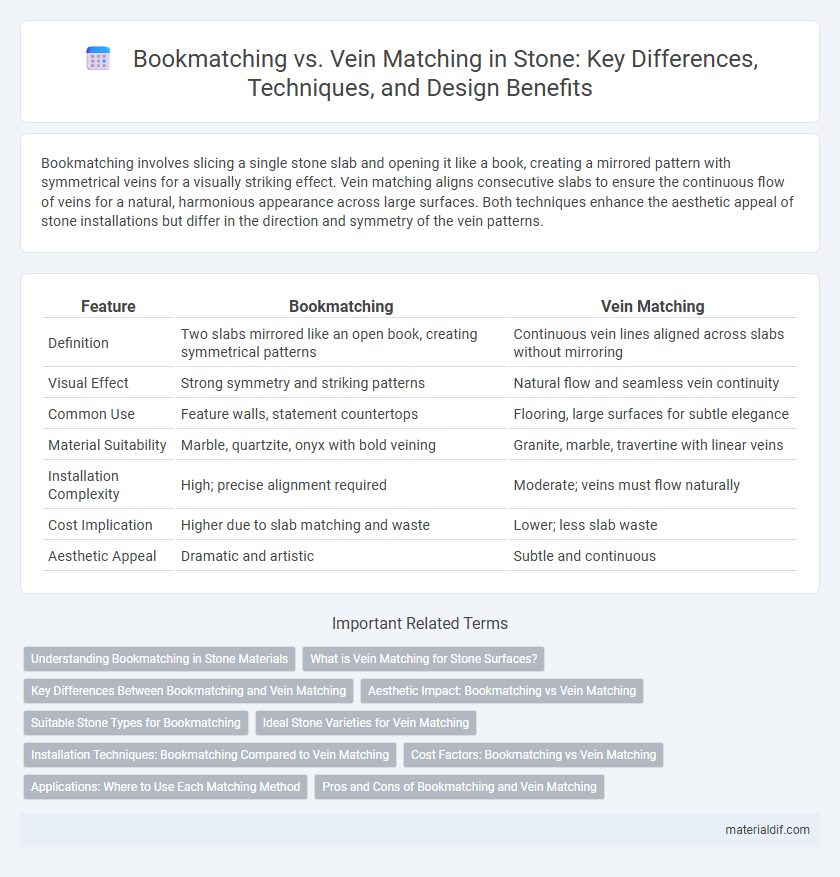Bookmatching involves slicing a single stone slab and opening it like a book, creating a mirrored pattern with symmetrical veins for a visually striking effect. Vein matching aligns consecutive slabs to ensure the continuous flow of veins for a natural, harmonious appearance across large surfaces. Both techniques enhance the aesthetic appeal of stone installations but differ in the direction and symmetry of the vein patterns.
Table of Comparison
| Feature | Bookmatching | Vein Matching |
|---|---|---|
| Definition | Two slabs mirrored like an open book, creating symmetrical patterns | Continuous vein lines aligned across slabs without mirroring |
| Visual Effect | Strong symmetry and striking patterns | Natural flow and seamless vein continuity |
| Common Use | Feature walls, statement countertops | Flooring, large surfaces for subtle elegance |
| Material Suitability | Marble, quartzite, onyx with bold veining | Granite, marble, travertine with linear veins |
| Installation Complexity | High; precise alignment required | Moderate; veins must flow naturally |
| Cost Implication | Higher due to slab matching and waste | Lower; less slab waste |
| Aesthetic Appeal | Dramatic and artistic | Subtle and continuous |
Understanding Bookmatching in Stone Materials
Bookmatching in stone materials involves slicing a single slab into two consecutive pieces, creating mirror-image patterns that resemble an open book. This technique enhances aesthetic appeal by highlighting natural symmetry and continuity in veining, commonly used in marble and onyx installations. Unlike vein matching, which aligns veins across separate slabs without mirror effects, bookmatching offers a dramatic, cohesive visual impact in architectural and interior design applications.
What is Vein Matching for Stone Surfaces?
Vein matching for stone surfaces involves aligning the natural veins and patterns across multiple slabs to create a continuous, flowing design that emphasizes the stone's unique characteristics. This technique is crucial in high-end applications where visual consistency and aesthetic harmony are desired, such as in countertops, wall cladding, and flooring. Unlike bookmatching, which mirrors slabs for symmetry, vein matching ensures the veins run seamlessly without repetitive patterns, enhancing the natural beauty and authenticity of materials like marble, quartzite, and granite.
Key Differences Between Bookmatching and Vein Matching
Bookmatching involves slicing a single slab of stone into two adjoining pieces that mirror each other, creating a symmetrical pattern resembling an open book. Vein matching aligns slabs based on continuous veins or lines, maintaining the natural flow of the stone's patterns across multiple pieces. The key difference lies in bookmatching's emphasis on symmetry and mirrored patterns, whereas vein matching prioritizes the seamless continuation of veins for a more organic visual effect.
Aesthetic Impact: Bookmatching vs Vein Matching
Bookmatching creates a mirror-image pattern by slicing a stone slab and opening it like a book, resulting in a symmetrical and dramatic visual impact that emphasizes luxury and elegance. Vein matching aligns the natural veins and patterns across adjacent slabs to create a continuous, flowing design that highlights the stone's organic beauty and subtlety. The choice between bookmatching and vein matching significantly influences the aesthetic atmosphere of a space, with bookmatching offering bold focal points and vein matching providing seamless, harmonious surfaces.
Suitable Stone Types for Bookmatching
Bookmatching is best suited for symmetrical stone types with consistent veining patterns such as marble, onyx, and certain granites, allowing for a mirror-image effect that enhances aesthetic appeal. Vein matching works optimally with stones that have linear or directional veins, like travertine and some limestones, emphasizing continuity across slabs in a linear fashion. Selecting the appropriate stone type for bookmatching ensures the natural patterns align perfectly, creating dramatic visual symmetry in interior applications.
Ideal Stone Varieties for Vein Matching
Ideal stone varieties for vein matching include marble, onyx, and quartzite, prized for their distinct, continuous veining patterns that create seamless flows across slabs. These stones offer high contrast and dramatic designs that enhance the aesthetic impact when veins are aligned precisely. Vein matching requires consistent veining and color tones, making these natural stones the preferred choice for luxury countertops and wall installations.
Installation Techniques: Bookmatching Compared to Vein Matching
Bookmatching installation involves aligning consecutive stone slabs so their veining mirrors each other, creating a symmetrical pattern that enhances visual continuity. Vein matching arranges slabs to maintain the flow of natural veins across surfaces, but without the mirror effect, offering a more linear and organic appearance. Bookmatching requires precise cutting and careful placement to achieve perfect symmetry, whereas vein matching allows for greater flexibility in alignment and is typically easier to install.
Cost Factors: Bookmatching vs Vein Matching
Bookmatching requires precise cutting and alignment of stone slabs, increasing labor and waste material costs compared to vein matching, which involves simpler layout and less material waste. The complexity of bookmatching typically results in higher fabrication and installation expenses due to the meticulous handling and pattern consistency needed. Vein matching offers a more cost-effective option as it involves matching adjacent stone slabs based on natural vein flow without requiring perfect mirrored symmetry.
Applications: Where to Use Each Matching Method
Bookmatching is ideal for applications requiring symmetrical patterns, such as feature walls, fireplace surrounds, and luxury countertops, enhancing visual harmony and elegance. Vein matching suits large surfaces like expansive floors and wall claddings, emphasizing continuous linear flow and natural stone veining. Choosing between these methods depends on the desired aesthetic effect and the specific architectural context of the space.
Pros and Cons of Bookmatching and Vein Matching
Bookmatching offers a striking symmetrical pattern by slicing stone slabs and mirroring them, enhancing aesthetic appeal in applications like countertops and wall cladding, but it requires precise cutting and increases material waste. Vein matching creates a more natural, continuous flow of stone veins across slabs, providing seamless visual unity ideal for large surfaces, although it can be challenging to align perfectly and incurs higher labor costs. Both techniques elevate visual impact in stone design, but selection depends on project scale, budget, and desired stylistic effect.
Bookmatching vs Vein Matching Infographic

 materialdif.com
materialdif.com